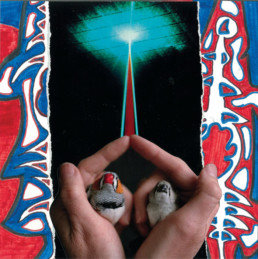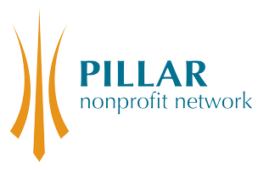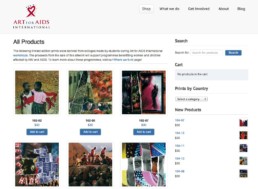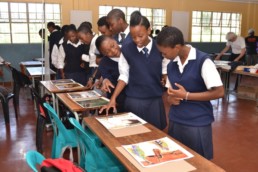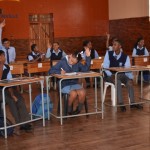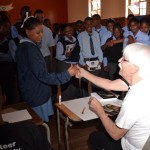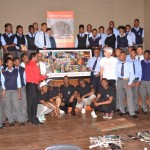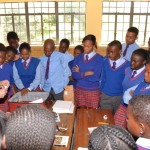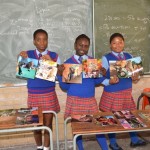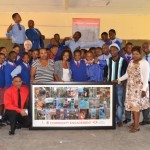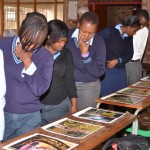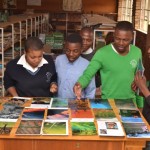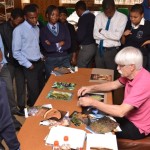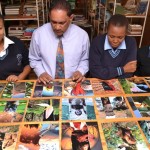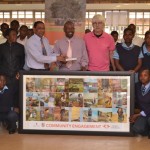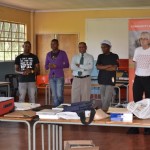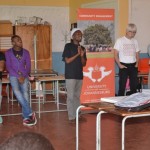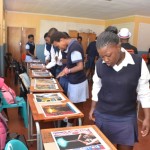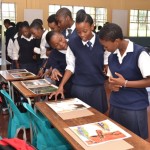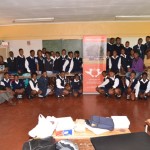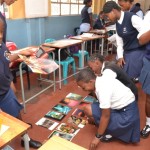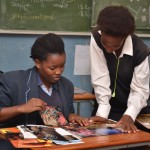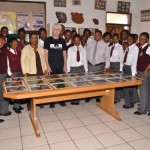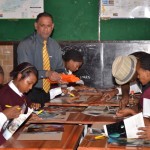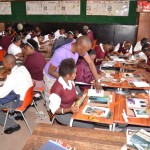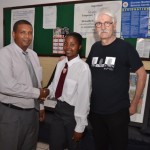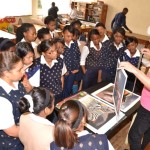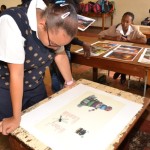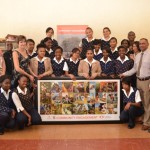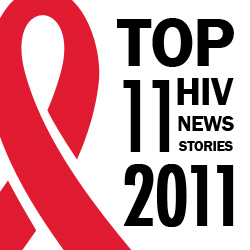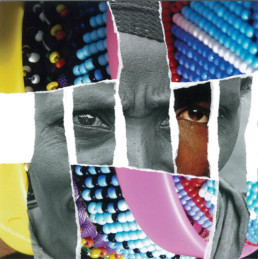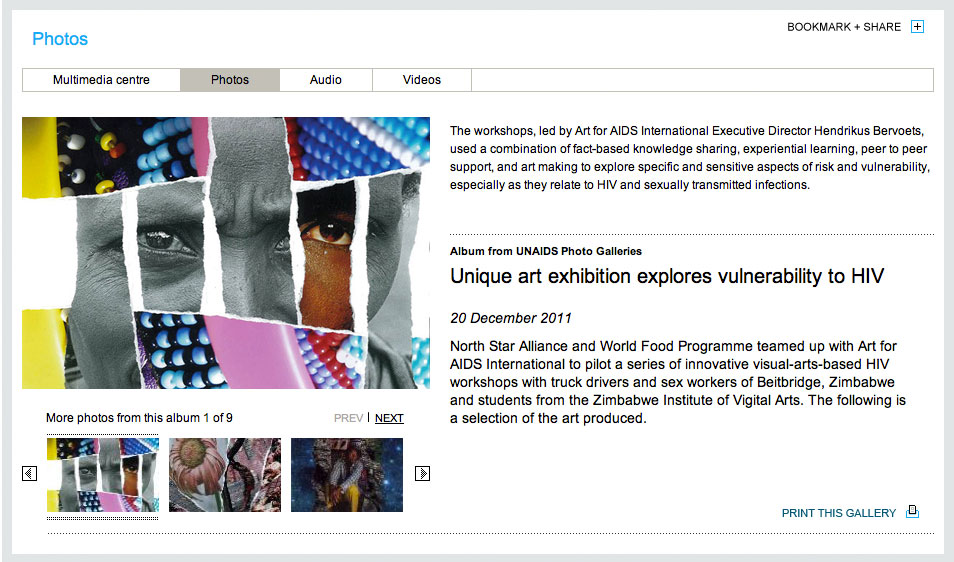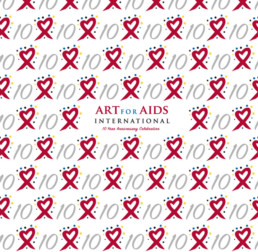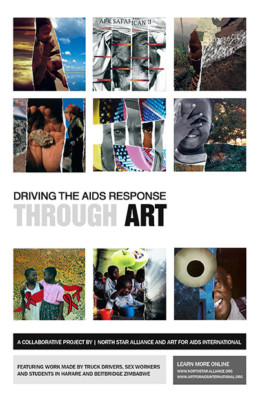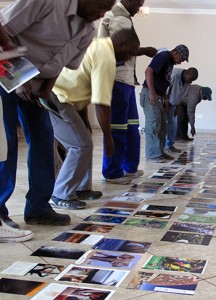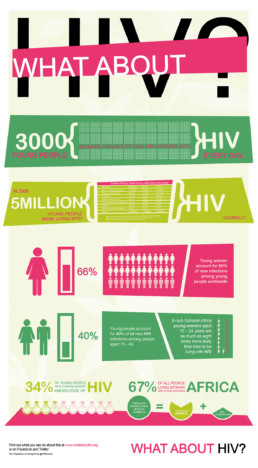A Letter of Thanks from Moosonee Public School
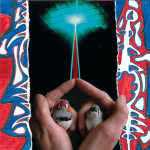 This past spring, Art for AIDS' Executive Director, Hendrikus Bervoets, traveled to Moosonee and Moose Factory Ontario for the third time in two years to host workshops with young people covering a range of topics including HIV, discrimination, and social justice. Recently, we were honoured to receive a letter of thanks from one of the teachers involved, which, with her permission, we wanted to share. While we consistently work to ensure that our workshops are engaging, fun, and educational for everyone involved, letters like this affirm that we are on the right track and are a source of motivation for our whole team:
This past spring, Art for AIDS' Executive Director, Hendrikus Bervoets, traveled to Moosonee and Moose Factory Ontario for the third time in two years to host workshops with young people covering a range of topics including HIV, discrimination, and social justice. Recently, we were honoured to receive a letter of thanks from one of the teachers involved, which, with her permission, we wanted to share. While we consistently work to ensure that our workshops are engaging, fun, and educational for everyone involved, letters like this affirm that we are on the right track and are a source of motivation for our whole team:
Although some of us may never travel the world, or even leave the little bubble that is Moosonee, I thought it was very educational for the students to meet Hendrkus; a world traveler with a humanitarian spirit.
Hendrkus relayed so many powerful and thought-provoking messages during his workshop; I know that many participants were touched by various things he said. For me, his comments of acceptance were very moving and encouraged me to be less judgmental and more open to the knowledge and experiences of those around me.
I have been racking my brain for months, trying to design a workshop that would prove to be a self-esteem builder while also teaching our students resiliency. As it turns out, all I had to do was have my students attend one of Hendrkus’ workshops! The empowerment, confidence and overall joy in the room throughout the two days was as infectious as it was incredible.
Words cannot express how grateful I feel for having had the opportunity to participate in the “Art for Aids” workshop. Being able to share it with the Grade 8 students of Moosonee Public School makes it that much better. I know that the messages of acceptance, social responsibility and self-worth that were communicated throughout the workshop will go a long way in aiding our students achieve lasting success in all of their endeavors.
A big thank you to our Supervisory Officer, Mr. Tom Steele, who had a vision of this workshop happening months ago and went to great lengths to ensure that it became a reality. And to Hendrkus, who spread a wonderful message of self-empowerment to all our Intermediate students while simultaneously taking them one step closer to becoming caring, informed citizens of the world. I look forward to when our paths cross again.
Emily Samuel
Grade 8 Teacher
Moosonee Public School
We would like to thank all of the students, teachers, and administrators from both the Moosonee Public School in Moosonee, Ontario, and the Ministik Public School in Moose Factory, Ontario, for their support, and the enthusiasm they've shown for our work. We are all touched and looking forward to our next opportunity to work in both communities.
Read about our previous trips to Moosonee and Moose Factory.
Art for AIDS selected as Finalist for Pillar Community Innovation Awards
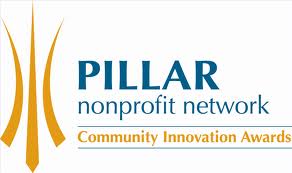 Each year, the Pillar Nonprofit Network recognizes organizations and individuals that demonstrate innovation, leadership, and collaboration within the not-for-profit sector through the Pillar Community Innovation Awards. This year, we are proud to announce that Art for AIDS International has been recognized as a finalist for Community Innovation alongside two other London-based programs.
Each year, the Pillar Nonprofit Network recognizes organizations and individuals that demonstrate innovation, leadership, and collaboration within the not-for-profit sector through the Pillar Community Innovation Awards. This year, we are proud to announce that Art for AIDS International has been recognized as a finalist for Community Innovation alongside two other London-based programs.
Previous Pillar Community Innovation Award recipients include Habitat for Humanity, the Boys' and Girls' Club of London, and Meals on Wheels. We would like to sincerely thank Pillar Nonprofit Network for recognizing our work, and to all other nominees for their commitment and dedication to the London and surrounding community.
The final award ceremony will take place on November 13, 2012 from 6:30-9:30 PM in the London Convention Centre. For more information on the event, or to view the full list of finalists under each category, please visit Pillar's Community Innovation Award website.
Art for AIDS Opens Online Gallery and Shop
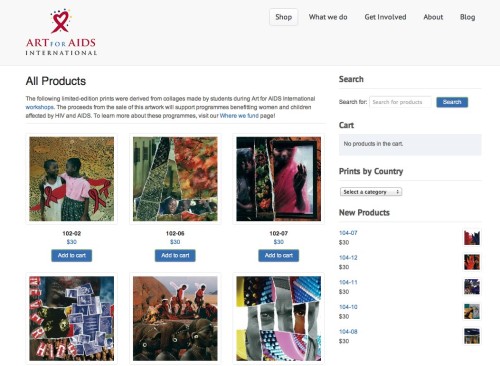 All of us at Art for AIDS International are proud to announce that we have just launched our new online shop!
All of us at Art for AIDS International are proud to announce that we have just launched our new online shop!
With this is a new and exciting feature we will be able to showcase and share the tremendous work that students produce during our workshops and make those works available to a broader global audience. Just like in our physical gallery, new prints will be regularly added and rotated through our online gallery, so stop by frequently to see and purchase new artwork.
Each print is part of a limited edition and has been hand-signed by the artist. The artwork is created during Art for AIDS International workshops with students from various countries including Canada, Zimbabwe, South Africa, the Netherlands and more that address the impact that HIV and AIDS is having on communities across Africa and around the world.
For just $30 you can purchase a piece of beautiful art as well as give back with proceeds supporting Art for AIDS parnter projects in sub-Saharan Africa working with women and children affected by HIV and AIDS.
Coupon Code
We are also pleased to announce that the first 100 orders will receive $10.00 off their total purchase. Just enter "NEWSHOP" as the coupon code in the shopping cart before you check-out.
Thanks to everyone for your continued support. Please let us know what you think of the new online gallery by leaving a comment below. We will continue to update it, and add new prints and features in the weeks to come.
Students use visual art to stop the spread of HIV in South Africa [Gallery]
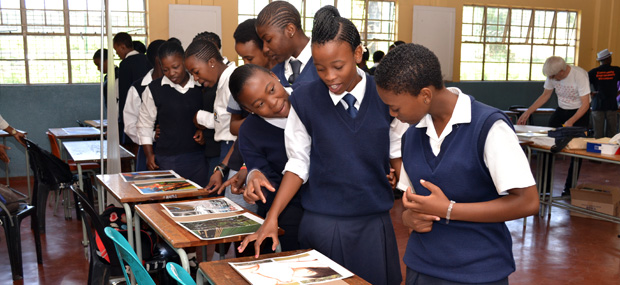
Over the past few months we've been incredibly busy hosting workshops with a growing group of students in Canada, and throughout southern Africa. Most recently, this has included two solid weeks of work with some incredible young people in Soweto and Johannesburg. [See photos below!]
Hendrikus Bervoets, Art for AIDS International's Executive Director, hosted workshops with 192 students in six high schools and at the University of Johannesburg in partnership with the University's Department of Community Engagement. These workshops introduced students to a range of themes including HIV prevention and testing, gender and racial equality, self-esteem, and social justice through the medium of art making.
“The student's excitement was really quite unbelievable. I walked into the classrooms as a complete and total stranger and talked to rooms full of South African students. While I was a stranger when I walked in, however, I felt that I walked out as a friend. In such a short period of time there was this phenomenal connection and discussion being made with young people” - Hendrikus Bervoets
All of the workshops were facilitated by Hendrikus with support from 8 University of Johannesburg students who are part of a collaborative Art for AIDS mentorship programme there. The secondary school workshops were also used to collect important data as part of a longitudinal study on information quality, comprehension and of course, student enjoyment during Art for AIDS workshops. This data helps us continue to ensure our workshops are effective, enjoyable, and tailored to be regionally relevant to the participants.
During the workshops, we were also privileged to notify a student from Noordgesig Secondary School, Busisiwe, that she had won a scholarship sponsored by the Ontario Teachers' Federation (OTF), culminating an Art for AIDS/OTF school Twinning Project organised last year between Noordgesig and Northern Lights Secondary School in Moosonee, Ontario.
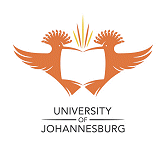 All of us at Art for AIDS would like to thank the Department of Community Engagement from the University of Johannesburg for their support and partnership, as well as the University’s mentorship students who volunteered their time to support the workshop process, and to act as role models for the secondary school participants. We would also like to thank the Ontario Teachers' Federation for their support, sponsorship, and for their dedication to empowering young people through education. Finally, we would like to thank each of the students for their questions, comments, and for the incredible pieces of artwork they produced and shared - which we will soon be sharing with all of you.
All of us at Art for AIDS would like to thank the Department of Community Engagement from the University of Johannesburg for their support and partnership, as well as the University’s mentorship students who volunteered their time to support the workshop process, and to act as role models for the secondary school participants. We would also like to thank the Ontario Teachers' Federation for their support, sponsorship, and for their dedication to empowering young people through education. Finally, we would like to thank each of the students for their questions, comments, and for the incredible pieces of artwork they produced and shared - which we will soon be sharing with all of you.
Holding workshops is an extremely important part of what Art for AIDS does. Although not everyone is infected with HIV, everyone is affected by it. It is crucial, therefore, that everyone, and especially young people, are educated about the realities of the the global AIDS epidemic, and engaged in the response. If you would like to learn more about our workshops, visit our Workshops page or contact us directly!
“All in all, it was fantastic. I came back to Canada with renewed energy and excitement for the work that I do".
Check out our gallery for photos from our workshops, and to catch a glimpse at some of the great artwork that the participants produced.
AIDS in 2011: A Year in Review
2011 was a mixed bag in the global response to AIDS. While exciting medical breakthroughs in treatment and prevention hint at tremendous potential to reduce the transmission of HIV, these were often offset by reduced financial investment, profiteering, and discriminatory national policies. As we enter the 4th decade of HIV, we wanted to take a look back at some of the biggest stories that defined the AIDS response in 2011.
11 Major Stories from 2011
AIDS turns 30

30 years ago, the United States Centers for Disease Control and Prevention (CDC) issued a report outlining five cases of what was believed to be a rare form of pneumonia. In retrospect, this report would be the first official one to outline what is now recognized widely as the HIV epidemic.
Read our special feature on 30 Years of HIV.
ARVs Prevent Infection

On May 12, the results of the HPTN 052 trial indicated that if an HIV-positive person adheres to an effective antiretroviral therapy regimen, the risk of transmitting the virus to their uninfected sexual partner can be reduced by 96 percent.
The story, which made global headlines in May, was recently hailed as the biggest breakthrough of 2011.
Anti-Gay Legislation
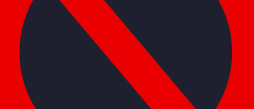
In May, Ugandan MPs backing an anti-homosexuality bill, which included a death penalty clause for repeat offenders, said they would move forward with it, despite President Museveni's calls for them to abandon it.
In November, Nigeria's Senate voted to criminalize gay marriage, gay advocacy groups and same-sex public displays of affection.
Contraception and the Risk of HIV
 In October, a seven-country study published in the Lancet showed that women using hormonal shots to prevent pregnancy, such as the contraceptive Depo-provera, increased their risk of contracting HIV, and doubled the chance that they transmit HIV to their partners. This was major news because helping women avoid unwanted pregnancy is an important part of reducing mother-to-child transmission.
In October, a seven-country study published in the Lancet showed that women using hormonal shots to prevent pregnancy, such as the contraceptive Depo-provera, increased their risk of contracting HIV, and doubled the chance that they transmit HIV to their partners. This was major news because helping women avoid unwanted pregnancy is an important part of reducing mother-to-child transmission.
Medicines Patent Pool

In July, the Medicines Patent Pool announced their first agreement with pharmaceutical company - Gilead Sciences - to improve access to HIV and Hepatitis B treatment in developing countries. The Patent Pool was created in 2010 to improve access to HIV medicines by enabling the negotiation of voluntary patent licences to generic pharma companies, enabling them to develop and distribute new formulations.
Generic Anti-Retrovirals under Fire
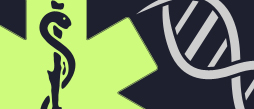
In March, thousands protested terms in the ongoing free trade agreement between the EU and India, which pushes for tougher intellectual property regulations - threatening the production of generic pharmaceuticals in India, which currently produces the majority of anti-retroviral drugs used in developing countries.
Read more in UNAIDS's Press Statement.
Funding Cuts for HIV
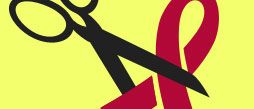
In November, poor funding resulted in the Global Fund's decision to cancel its 11th round of funding. The Global Fund is responsible for about 70% of HIV treatment in developing countries.
Earlier in the year, the Kaiser Family Foundation and UNAIDS released a report showing that funding fell from US$7.6 billion in 2009 to $6.9 billion in 2010 - the first time funding has dropped in more than a decade.
New Targets in Global AIDS Response
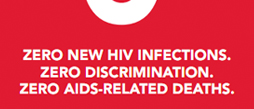 In June, at the UN High Level Meeting on AIDS, a new set of targets was outlined for the global AIDS response. Simply put: "Zero new infections, zero stigma and zero AIDS-related deaths". The meeting concluded with the adoption of a declaration that seeks, by 2015, to double the number of people on ARVs to 15 million, end mother-to-child transmission, halve TB-related deaths in people living with HIV, and increase preventive measures for the "most vulnerable populations".
In June, at the UN High Level Meeting on AIDS, a new set of targets was outlined for the global AIDS response. Simply put: "Zero new infections, zero stigma and zero AIDS-related deaths". The meeting concluded with the adoption of a declaration that seeks, by 2015, to double the number of people on ARVs to 15 million, end mother-to-child transmission, halve TB-related deaths in people living with HIV, and increase preventive measures for the "most vulnerable populations".
Crowdsourcing New HIV Strategy
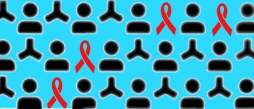
In September, UNAIDS, recognizing the important role of young people in the global AIDS response, launched a digital campaign aimed at encouraging young people to crowdsource a new strategy on HIV and Youth. The campaign, #CrowdOutAIDS, provides platforms for young people to interact and engage with each other regarding issues related to HIV in their community and seeks to reach a collective set of agreements out of these interactions.
More Political Misinformation
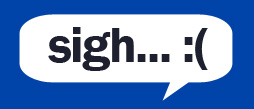 In November, Leader of the Democratic Alliance in South Africa, Helen Zille, called for people who knowingly infected others with HIV to be charged with attempted murder, and quested why the government should pay for people who contracted HIV through "irresponsible behaviour".
In November, Leader of the Democratic Alliance in South Africa, Helen Zille, called for people who knowingly infected others with HIV to be charged with attempted murder, and quested why the government should pay for people who contracted HIV through "irresponsible behaviour".
On August 1st, Uganda's Minister of Health, Christine Ondoa, claimed she knew three people who had been cured of HIV through prayer.
New HIV Vaccine Approved for Trial
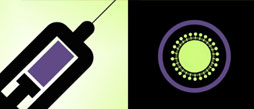
In December, the first and only preventative HIV vaccine based on a genetically modified killed whole virus has received approval by the FDA to start human clinical trials.
Developed at The University of Western Ontario, with the support of Sumagen Canada, the vaccine (SAV001) holds tremendous promise, stimulating strong immune responses in preliminary tests with no adverse effects or safety risks.
As we enter the 4th decade of HIV, there is no better time than now to celebrate success and renew our committment as responsible individuals, volunteers, activists, and sponsors. Reaching Zero New Infections is possible - and we hope it will be at the top of everyone's resolution list this year.
UNAIDS features collaborative Art for AIDS project
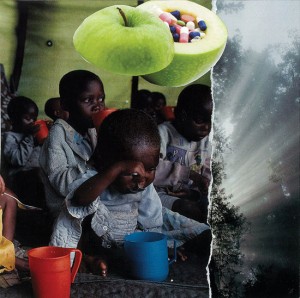 In September we told you about a collaborative pilot project between North Star Alliance, the World Food Programme, and of course, Art for AIDS, focused on extending our arts-based workshops model to truck drivers, sex workers, and students located in both Beit Bridge and Harare, Zimbabwe. While this was by no means our first student-workshop (check out our full list of workshop locations), it was the first time we had hosted workshops with truck drivers and sex workers, two populations that are particularly vulnerable to, and disproportionately affected by HIV, STIs, and other communicable diseases.
In September we told you about a collaborative pilot project between North Star Alliance, the World Food Programme, and of course, Art for AIDS, focused on extending our arts-based workshops model to truck drivers, sex workers, and students located in both Beit Bridge and Harare, Zimbabwe. While this was by no means our first student-workshop (check out our full list of workshop locations), it was the first time we had hosted workshops with truck drivers and sex workers, two populations that are particularly vulnerable to, and disproportionately affected by HIV, STIs, and other communicable diseases.
Following the workshops, all of us at Art for AIDS were excited by both the powerful artwork each participant produced, and by the high quality discussions about HIV that came out of the workshops. Over the past few months, we've been even more excited to watch public enthusiasm for this project grow.
Thanks to tremendous support from both North Star Alliance and the World Food Programme this project was featured with a large exhibition in September at the International Fund for Agricultural Development's (IFAD) Global Knowledge Share Fair, and at the World Food Programme's Head Quarters over World AIDS Day. The project has also been featured at exhibits in London and Toronto, Canada, and in Utrecht, the Netherlands.
This week, UNAIDS (the Joint United Nations Programme on HIV/AIDS) highlighted this initiative as well by posting a special photo gallery showcasing some of the works of art produced along with an explanation of the project. To view this gallery, please click the image below:
We would like to thank UNAIDS for highlighting this feature, and both North Star Alliance and the World Food Programme for the tremendous work they do, and the vision and support they've brought to this initiative.
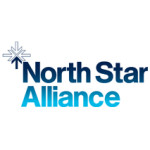
About North Star Alliance
North Star Alliance is a not-for-profit public private partnership that provides healthcare and information to truck drivers, sex workers, and border communities through a network of roadside health clinics across Africa.
You can learn more about North Star by visiting them online or by joining them on Facebook.
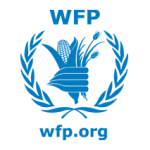
About The World Food Programme
WFP is the food aid arm of the United Nations system, and the largest humanitarian agency fighting hunger.
You can learn more about WFP by visiting them online or by joining them on Facebook.
Celebrating 10 Years of Art for AIDS International
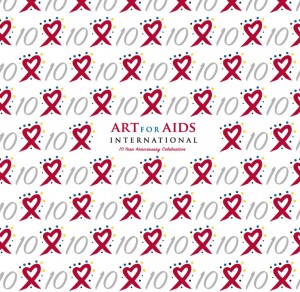
The Power of 10 years and 10,000 Young People
Ten years ago, Art for AIDS International set out to stop the spread of HIV by inspiring young people, through art, to play an active and engaged role in the global AIDS response.
Thanks to support from these young people, their communities, and a growing network of partners, we’ve had the opportunity to host workshops with over 10,000 young people, at over 300 schools from across Canada, and throughout Africa and Europe. The outcome of this incredible community effort is a powerful collection of art, produced by young people, that has raised international awareness about AIDS, and over 1 million dollars to support community organizations in Africa working with women and children affected by HIV and AIDS.
On the 10th Anniversary of Art for AIDS, we want to celebrate the tremendous impact that a community-driven initiative has had on the lives of young people in classrooms around the world, and on the lives of young people across Africa, who have benefitted directly.
Power of 10 Portfolio
To thank everyone who has made this possible, we are re-releasing the 20 prints that started it all (10 from each of our first two portfolios). This "Power of 10" portfolio will be sold at a number of exciting events that will run throughout the remainder of 2011 and into 2012. Further, to make sure that as many people as possible can enjoy this work, prints will be available for only $10 each with proceeds supporting Art for AIDS International and the work of our partner organizations in Africa.
How you can get involved
There are a number of ways you can support Art for AIDS International through the Power of 10 campaign:
- Become a volunteer at Art for AIDS International;
- Host an event in your home, school, or community;
- Sponsor the campaign directly;
- Purchase Power of 10 prints.
If you would like to support Art for AIDS International and the Power of 10 campaign in any of these ways, please contact us.
You can also check back on our website as we post exciting news, events, and updates over the coming weeks.
Thank you
While Art for AIDS began as a small - one person - secondary school initiative, it was ultimately the power of community that has allowed us to grow, engage more young people, and provide support to women and children in some of the communities hardest hit by HIV in Africa.
We would like to thank everyone who has been involved from our inception for their dedication, initiative, and the passion they've shown for this project. This includes our enthusiastic volunteers and board, each of the students, teachers, and school boards who've welcomed us to their school community, our tremendous group of public and private sponsors, and finally, everyone who has shown their recognition for the power of art in addressing global challenges like the HIV epidemic, whether through kind words, telling others about our work, or purchasing one of our students' works of art.
Thank you.
Sharing Knowledge, Sharing Innovation: North Star and Art for AIDS Exhibit in Rome
 Last week, Art for AIDS International opened a large exhibit in collaboration with North Star Alliance and the World Food Programme at the Second Annual Global Agriknowledge Share Fair in Rome - hosted at the headquarters of the International Fund for Agricultural Development (IFAD), a UN agency responsible for combating rural hunger and poverty in developing countries.
Last week, Art for AIDS International opened a large exhibit in collaboration with North Star Alliance and the World Food Programme at the Second Annual Global Agriknowledge Share Fair in Rome - hosted at the headquarters of the International Fund for Agricultural Development (IFAD), a UN agency responsible for combating rural hunger and poverty in developing countries.
The exhibit, which featured the recently launched North Star Alliance / Art for AIDS International portfolio, presented a large selection of artwork produced by truck drivers, sex workers, and young people from Harare and Beitbridge Zimbabwe, made during a recent workshop series hosted by Hendrikus Bervoets, Founder and Executive Director of Art for AIDS International.
The goal of this exhibit was to raise awareness about the impact of HIV and STIs on mobile populations, and on their direct and indirect contacts across Africa. Further, the exhibit highlighted tremendous initiatives by North Star Alliance and the World Food Programme which address these issues.
"While Art for AIDS International has traditionally worked with young people, we realized it was important to recognize hidden links in the transmission of HIV in Africa", explained Hendrikus.
Truck drivers, and the communities surrounding transport hubs, have traditionally lacked access to health care and information, and as a result, have been disproportionately affected by HIV and other diseases.
"By teaming up with North Star Alliance, an international not-for-profit organization that provides health care to mobile populations and communities surrounding borders and truck stops, we were able to adapt the Art for AIDS workshop model to bring important information, and hopefully a fun experience, to two communities heavily affected by these issues".
The exhibit, which ran from 26-29 September, was well received with many people stopping by to purchase prints - the proceeds of which will support both Art for AIDS International and North Star Alliance projects in southern Africa.
We would like to thank IFAD, the World Food Programme, and North Star Alliance for their support.
Over the next few weeks Art for AIDS International, and North Star Alliance will scheduling a series of exhibits to further feature this exciting project. Stay tuned for more details.
Driving the AIDS Response through Art
The following post originally appeared on the North Star Alliance blog on August 10, 2011.

On 26-29 July, North Star Alliance teamed up with Art for AIDS International to pilot a series of innovative visual-arts-based HIV workshops with truck drivers and sex workers in the community of Beitbridge, Zimbabwe.
These workshops, led by Art for AIDS International Executive Director Hendrikus Bervoets, use a combination of fact-based knowledge sharing, experiential learning, peer-peer support, and art making to explore specific and sensitive aspects of risk and vulnerability, especially as they relate to HIV and STI infection.
 “Although HIV awareness is high, fear and stigma prevent many from getting tested and seeking treatment. These innovative workshops show that the process of combining health information, storytelling and art-making can be informative, therapeutic and fun for everyone involved” says Robin Landis, Director of Communications for North Star Alliance.
“Although HIV awareness is high, fear and stigma prevent many from getting tested and seeking treatment. These innovative workshops show that the process of combining health information, storytelling and art-making can be informative, therapeutic and fun for everyone involved” says Robin Landis, Director of Communications for North Star Alliance.
What is perhaps most exciting about these workshops, however, is the resulting body of artwork.
During the workshops participants translate their insights into the production of original collage artwork. Each collage is produced as original machine-made limited edition prints that are signed and numbered.
These prints will create a unique portfolio which will be collaboratively exhibited by North Star Alliance and Art for AIDS International to raise awareness about the impact of HIV on mobile populations, and proceeds to support both organisations’ work in Southern Africa. The portfolio will be officially released early this fall, so you'll have to wait until then to see it!

The workshops also provided North Star with an opportunity to collect mixed-method research on these key populations. “By interacting with truck drivers and sex workers outside of the clinic setting we were able to deepen our understanding of their health needs and tackle sensitive issues like HIV stigma" says Robin Landis.
North Star will use the participants’ feedback and in-depth interviews to improve our targeted services and programmes.
What about HIV? [INFOGRAPHIC]

Thirty years into the response to HIV, an estimated 3000 young people are newly infected with HIV everyday. Many young people living with HIV still do not have access to treatment and only 34% of all young people have correct and comprehensive knowledge about HIV and how to protect themselves. That's why more than 150 young HIV activists from across the world gathered for a three-day summit in Bamako, Mali, last week to rally a youth-led response to HIV in lead up to the United Nations General Assembly High Level Meeting on AIDS (taking place in New York from 8 to 10 June 2011). Read more
